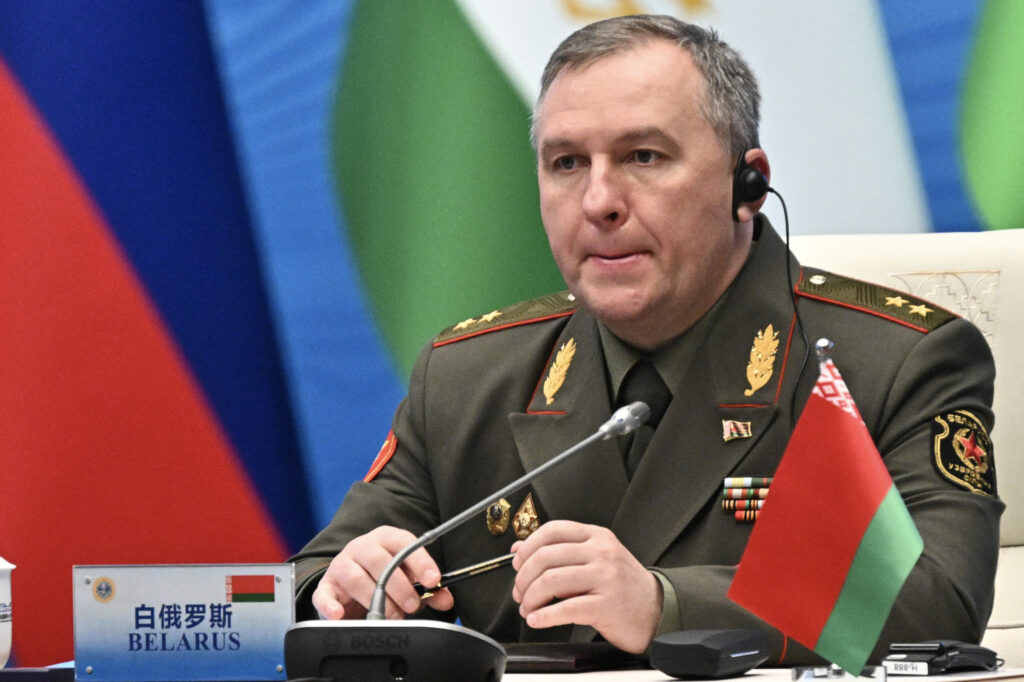Belarusian Defense Minister Viktor Khrenin announced Wednesday that nuclear weapons exercises practicing deployment will soon be held near Borisov in the Minsk Region, occurring as U.S. President Donald Trump and Russian President Vladimir Putin are scheduled to meet in the United States.
Why It Matters
The latest nuclear exercises follow Russia’s formal revision to its own nuclear doctrine in late 2024, to lower the threshold for potential use of nuclear weapons—a change that Western officials and analysts said was meant to deter expanded military support for Ukraine.
Belarus has been one of Russia’s staunchest allies throughout the yearslong war between Russia and Ukraine that escalated when Putin invaded sovereign territory across the border in Eastern Europe.
Putin and Trump are slated to meet one-on-one this Friday at Joint Base Elmendorf-Richardson in Alaska—the largest military facility the state—as the world leaders intend to discuss options for ending the conflict in Ukraine that began in February 2022. European venues such as Vienna and Geneva were ruled out as a meeting spot due to the legal risks of hosting Putin, who faces an International Criminal Court arrest warrant for war crimes.
In July, Trump and former Russian President Dmitry Medvedev engaged in a back-and-forth about a peace deal and nuclear provocations, with Trump telling Putin’s confidant that he should “watch his words” and that he is straying into “dangerous territory.”
What To Know
Khrenin said Wednesday that main troop maneuvers for the Belarus-Russia Zapad-2025 exercises would include use of the Oreshnik system, according to Belarusian and Russian state media.
The primary active events and troop operations for Zapad-2025 would be concentrated on training grounds near Borisov in the Minsk Region, with the larger exercise set for September 12-16, according to Belarusian officials.
“As it was previously stated by the head of state, all major operational activities and troop maneuvers will be concentrated in the central part of our country, at our main training grounds near Borisov,” Khrenin told SB.Belarus Today, adding that four of the five fortified areas, established on presidential directives for national defense operations, are fully prepared.
“Currently, four of these five fortified zones are operational; they have been handed over for use and are actively engaged in combat training exercises,” he added. “During Zapad-2025, we also plan to conduct troop training in two of these areas, where small units will execute practical tasks aimed at repelling potential adversaries.”
This is part of a planned event with exercises held every two years, he added, rather than “some sudden decision.”
Belarus reported that all components of its armed forces would participate, with core contingents from the Western and North-Western Commands and special operations forces taking part in the maneuvers near Borisov.
Minsk announced that participants would practice countering airstrikes, combating enemy sabotage groups, and planning nuclear-weapons deployment—including with the Oreshnik system, an intermediate-range weapon Russia previously used in strikes targeting Ukraine.
‘Fundamentally Irreconcilable’ Worldviews
Russia showed “utter disrespect” of Trump and the U.S. when it launched the largest combined drone and missile attack on Ukraine hours after Trump and Putin ended their phone call on July 3, Mikhail Alexseev, political science professor at San Diego State University, told Newsweek via email.
“This comes after months of Moscow delaying and obstructing Trump’s bold and noble efforts to bring the war to end through negotiations,” Alexseev said. “This disrespect is not surprising. Putin’s anti-Americanism is deep-seated, though often skillfully disguised when he wants to manipulate other leaders.
“It goes back to his days feeling humiliated and infuriated by the Soviet Union’s collapse while he served as a KGB officer in the communist East Germany.”
Alexseev said one of Russia’s underlying objectives as part of its invasion of Ukraine goes beyond conquering people and territory “but to signal to the rest of the world that America will never again be first, that it cannot protect its friends and allies, even those who share its fundamental values, such as freedom of speech and religion.”
“In that sense, Putin’s goals and Trump’s worldview are fundamentally irreconcilable,” he said.
What People Are Saying
U.S. Treasury Secretary Scott Bessent told BloombergTelevision in an interview on Wednesday morning: “I think everyone has been frustrated with President Putin. We expected that he would come to the table in a more fulsome way. It looks like he may be ready to negotiate, and we put secondary tariffs on the Indians for buying Russian oil. And I could see, if things don’t go well, then sanctions or secondary tariffs could go up.”
Bessent added: “I’m not going to get ahead of the president, but the president is the best at creating leverage for himself, and he will make it clear to President Putin that all options are on the table.”
Ukrainian President Volodymyr Zelensky, during a meeting with European leaders, he believes Putin “is bluffing” ahead of his talks with Trump—accusing Putin of “trying to apply pressure on all sectors of the Ukrainian front” to project that Russia is “capable of occupying all of Ukraine.”
What Happens Next
Belarus reported that three Collective Security Treaty Organization (CSTO) exercises—Search, Echelon, and Interaction—would take place from August 31 to September 6 at the Vitebsk training ground. Russian units had already arrived with other CSTO contingents expected to join.
NATO and neighboring countries said they would continue to monitor troop movements and exercises. Western officials reiterated public statements that doctrinal changes by Moscow increased the need for vigilance.
Read the full article here
